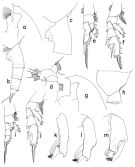|
|
 |
Fiche d'espèce de Copépode |
|
|
Calanoida ( Ordre ) |
|
|
|
Clausocalanoidea ( Superfamille ) |
|
|
|
Euchaetidae ( Famille ) |
|
|
|
Paraeuchaeta ( Genre ) |
|
|
| |
Paraeuchaeta megaloba Park, 1995 (F,M) | |
| | | | | | | Syn.: | Euchaeta megaloba : Park, 1994 (p.322) | | | | Ref.: | | | Park, 1995 (p.44, Descr.F,M, figs.F,M) |  issued from : T. Park in Bull. Scripps Inst. Oceanogr. Univ. California, San Diego, 1995, 29. [p.142, Fig.32]. Female: a, forehead (left side); b, urosome (left); c, genital somite (left); d, Mx1 (first inner lobe omitted), posterior; e, P1 (anterior); f, P2 (anterior). Nota: Similar in habitus to P. scotti but in lateral view, rostrum relatively small, pointing nearly parallel to anterior dorsal margin of forehead. Genital somite relatively long; its dorsal hump less conspicuous than in P. scotti ; ventral margin of genital flange more or less convex; posterior edge of genital field produced into a large lobe; posterior margin of genital prominence meeting posterior ventral wall of somite in a smooth curve. dorsal hump of 2nd urosomal somite more pronounced than in P. scotti. Cephalosomal appendages similar to thoes of P. scotti except that outer lobe of Mx1 with 6 long setae and a minute seta proximally. In P1 exopod, outer spine of 1st segment relatively well developed; outer spine of 2nd segment extending beyond base of following outer spine by 1/4 its length. In P2 exopod, outer spine of 2nd segment extending a little beyond base of following outer spine; 2nd outer spine of 3rd segment extending beyond base of 3rd by 1/6 its length; 1st outer spine of 3rd segment thick and about 1.5 times length of 3rd; posterior incision of marginal lobe bearing 2nd outer spine of 3rd segment reaching level of preceding incision. Male: g, forehead (left); h, last pedigerous and genital somites (left); i, P1 (anterior); j, P2 (anterior); k, distal exopodal segments of left 5th leg (anterior, tilted clockwise); l, idem (anterior, tilted counterclockwise); m, idem (lateral, tilted clockwise).
|
 Paraeuchaeta megaloba Paraeuchaeta megaloba Female: 1 - See key to species Groups and independent species of Paraeuchaeta (p.30): malayensis species Group. 2 - Outer spine of 2nd exopodal segment (or the 2nd of the first 2 exopodal segments forming a proximal, compound segment) of P1 normally developed (Fig.32-e). 3 - Outer lobe of Mx1 with 6 long setae in addition to 1 or 2 minute setae proximally (Fig.32-d). 4 - Genital somite without a conical process on left side close to anterior base of genital prominence (Fig.32-c). 5 - Dorsally and ventrally, genital somite symmetrical. 6 - Laterally, genital flange with normal posterior lobe (Fig.32-c). 7 - Laterally, genital somite with more or less smooth dorsal margin (Fig.32-c). 8 - Laterally, genital prominence with nearly straight or only slightly bulging posterior margin (Fig.32-c). 9 - Outer lobe of Mx1 with 6 long setae plus 1 or 2 very small setae (Fig.32-d). 10 - In 3rd exopodal segment of P2, 2nd marginal lobe separated from segment by very deep cleft and has long outer spine (Fig.32-f).
| | | | | NZ: | 7 | | |
|
Carte de distribution de Paraeuchaeta megaloba par zones géographiques
|
| | | | Loc: | | | NE Atlant. (off NW Cape Finisterre), Indonesia-Malaysia, S Japan, California, G. of California, S America, Pacif. (central S), Tasman Sea
Type locality: 13°47'S, 77°49'W. | | | | N: | 1 | | | | Lg.: | | | (3) F: 7,3-6,08; M: 5,83; {F: 6,08-7,30; M: 5,83} | | | | Rem.: | Park (1995, p.44) found this species widely in the Pacific: along the west coast of North and South America, including the Gulf of California, between 38°N and 35°S; in the central South Pacific at 39°S and 45°S; in the Tasman Sea; in the Banda Sea; off southern Japan; northeastern Atlantic between 17°W and 20°W and between 46°N and 49°N. | | | Dernière mise à jour : 27/01/2015 | |
|
|
 Toute utilisation de ce site pour une publication sera mentionnée avec la référence suivante : Toute utilisation de ce site pour une publication sera mentionnée avec la référence suivante :
Razouls C., Desreumaux N., Kouwenberg J. et de Bovée F., 2005-2025. - Biodiversité des Copépodes planctoniques marins (morphologie, répartition géographique et données biologiques). Sorbonne Université, CNRS. Disponible sur http://copepodes.obs-banyuls.fr [Accédé le 01 janvier 2026] © copyright 2005-2025 Sorbonne Université, CNRS
|
|
 |
 |




